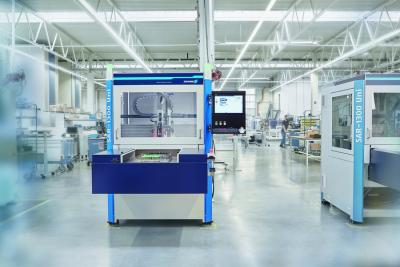
SCHUNK Electronic Solutions is bringing two depaneling machines with large installation spaces onto the market: the SAR-1300-Mono-Smart and the SAR-1700. The machines mill and saw individual PCBs from a large PCB panel - the maximum panel size is 600 x 500 millimeters.
"Further developments in printed circuit board technology face new challenges for electronics manufacturers and lead to increasing requirements on depaneling machine technology", says Jochen Ehmer, managing director of SCHUNK Electronic Solutions. "Larger installation spaces are in demand, such as for separating large entire PCBs or long panels to be milled in strips. We meet this demand with the new models."
SCHUNK Electronic Solutions is the world's first manufacturer to design modular depaneling machines. The advantage for electronic manufacturers is they can buy a basic version of the machine and then retrofit it later – such as with additional milling modules, a camera system, or a robot arm that takes over the loading and unloading and reduces personnel costs. "The depaneling machines require a low initial investment and grow flexibly along with companies", says Ehmer. "Companies gain future security for the Industry 4.0 era, where you need to economically manage small batch sizes and frequent product changes."
Customers benefit from process reliability, low electricity consumption, and short cycle times. The SAR-1300-Mono-Smart achieves separation efficiency of up to four meters per minute, and due to the linear motor axes and modern control technology, the milling accuracy is +/-0.1 millimeter. The SAR-1700 achieves the milling speed of the SAR-1300-Mono-Smart and also saws with a speed of up to ten meters per minute. Even with this high performance, the machine is saving energy. The power consumption of the SAR 1700 is 800 watts, the SAR 1300 is only 700 watts, which approximately corresponds to a microwave.
Contact Details
Related Glossary Terms
- gang cutting ( milling)
gang cutting ( milling)
Machining with several cutters mounted on a single arbor, generally for simultaneous cutting.
- linear motor
linear motor
Functionally the same as a rotary motor in a machine tool, a linear motor can be thought of as a standard permanent-magnet, rotary-style motor slit axially to the center and then peeled back and laid flat. The major advantage of using a linear motor to drive the axis motion is that it eliminates the inefficiency and mechanical variance caused by the ballscrew assembly system used in most CNC machines.
- milling
milling
Machining operation in which metal or other material is removed by applying power to a rotating cutter. In vertical milling, the cutting tool is mounted vertically on the spindle. In horizontal milling, the cutting tool is mounted horizontally, either directly on the spindle or on an arbor. Horizontal milling is further broken down into conventional milling, where the cutter rotates opposite the direction of feed, or “up” into the workpiece; and climb milling, where the cutter rotates in the direction of feed, or “down” into the workpiece. Milling operations include plane or surface milling, endmilling, facemilling, angle milling, form milling and profiling.
- milling machine ( mill)
milling machine ( mill)
Runs endmills and arbor-mounted milling cutters. Features include a head with a spindle that drives the cutters; a column, knee and table that provide motion in the three Cartesian axes; and a base that supports the components and houses the cutting-fluid pump and reservoir. The work is mounted on the table and fed into the rotating cutter or endmill to accomplish the milling steps; vertical milling machines also feed endmills into the work by means of a spindle-mounted quill. Models range from small manual machines to big bed-type and duplex mills. All take one of three basic forms: vertical, horizontal or convertible horizontal/vertical. Vertical machines may be knee-type (the table is mounted on a knee that can be elevated) or bed-type (the table is securely supported and only moves horizontally). In general, horizontal machines are bigger and more powerful, while vertical machines are lighter but more versatile and easier to set up and operate.
- sawing machine ( saw)
sawing machine ( saw)
Machine designed to use a serrated-tooth blade to cut metal or other material. Comes in a wide variety of styles but takes one of four basic forms: hacksaw (a simple, rugged machine that uses a reciprocating motion to part metal or other material); cold or circular saw (powers a circular blade that cuts structural materials); bandsaw (runs an endless band; the two basic types are cutoff and contour band machines, which cut intricate contours and shapes); and abrasive cutoff saw (similar in appearance to the cold saw, but uses an abrasive disc that rotates at high speeds rather than a blade with serrated teeth).

